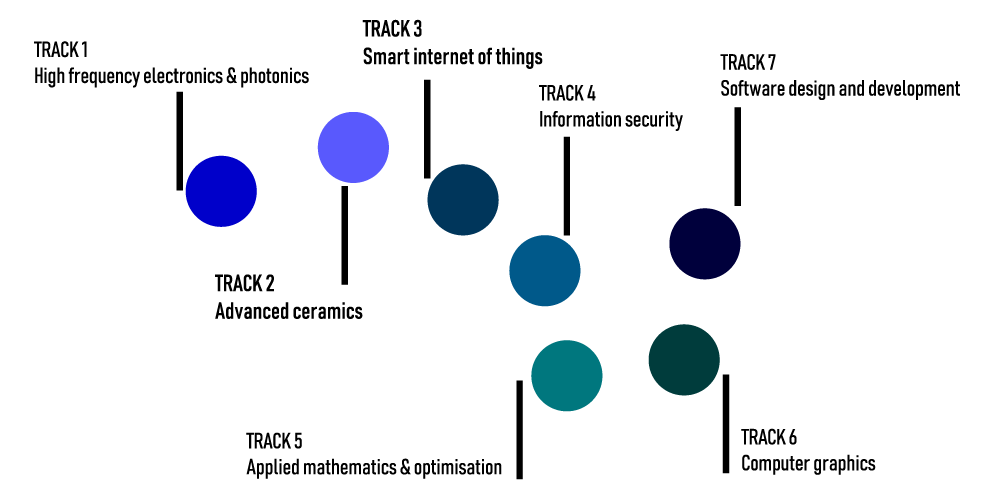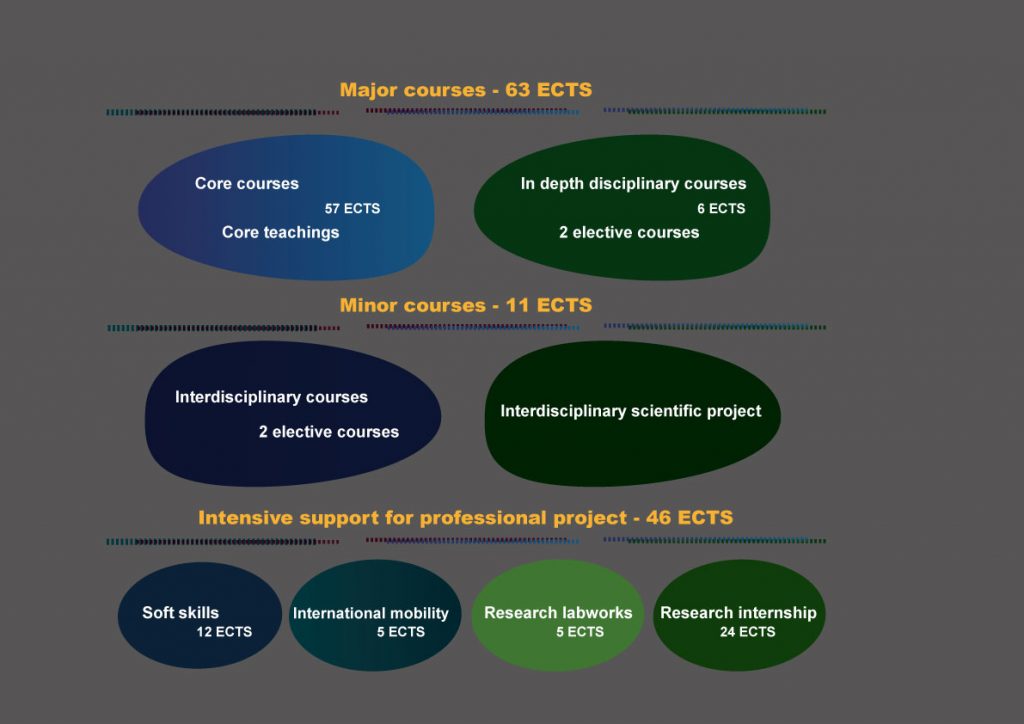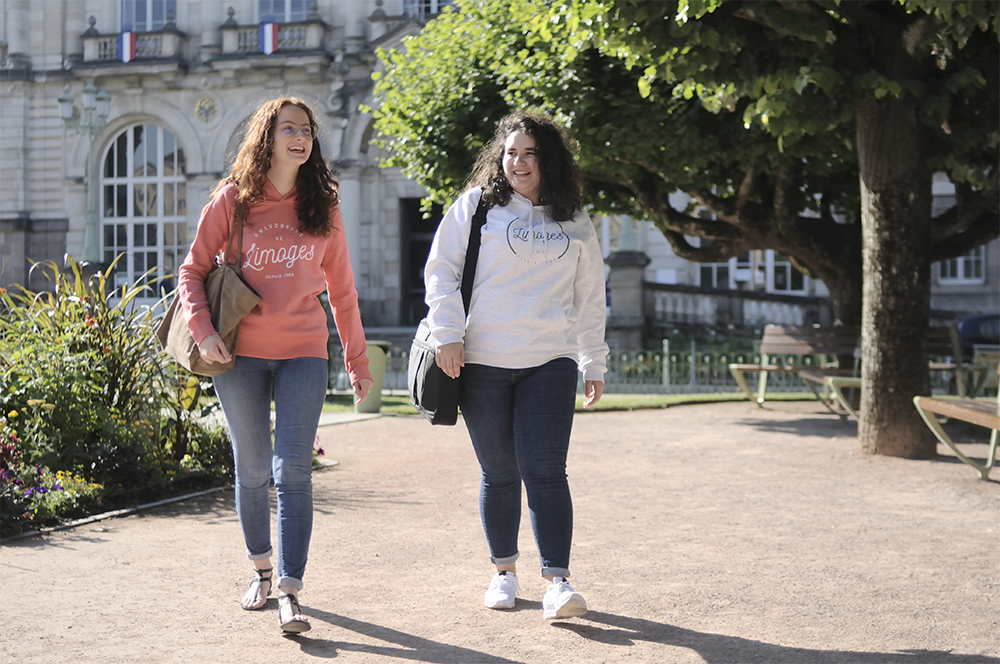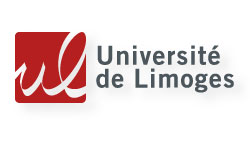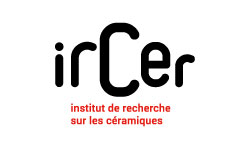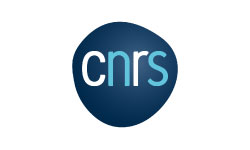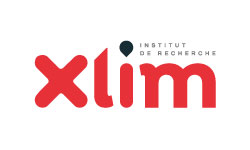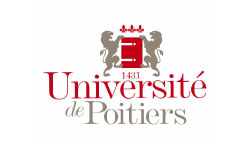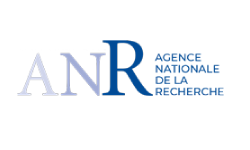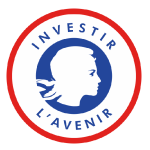CERAMICS & ICT – GRADUATE SCHOOL
The Ceramics & ICT TACTIC* Graduate School (GS) aims at training future highly skilled professionals in the domains of Ceramics and Information & Communication Technologies (ICT), able to understand the challenges and needs of the international research and industry and fully exploit the innovation potential of the interface between Ceramics and ICT. Led by the University of Limoges, in partnership with the University of Poitiers and CNRS, it benefits from a unique industrial, research and training ecosystem in Europe in the domains of Ceramics and ICT.
The GS master level program consists in 7 highly connected tracks covering ceramics, photonics, microwave electronics, internet of things, applied mathematics, computer science and cybersecurity. It has been designed to give the students not only a deep knowledge in one disciplinary field but also, thanks to an interdisciplinary approach, a better understanding of the applications, challenges, needs and constrains in the other disciplinary fields. It tackles many societal challenges such as sustainable development, energy, health, transport and mobility, communication and cybersecurity.
*TACTIC – Transverse Actions between advanced Ceramics and TIC.
Ceramics & ICT GS is led by the University of Limoges, in partnership with the University of Poitiers, and the CNRS.
These masters are backed by the XLIM laboratory, IRCER laboratory and LabEx ∑Lim.
Courses program
The common structure of the graduate program promotes multidisciplinarity, innovation by cross-fertilisation, immersion in research laboratories, international mobility and connections with the socio-economic world:
– Disciplinary courses giving strong skills and a high level of specialisation in one of the 7 disciplinary domains;
– Interdisciplinary teachings comprising theoretical and practical courses at the interface between the 7 tracks (for instance, one can cite the following areas: cybersecurity, photonics for health, additive manufacturing for 5G);
– Long research/industry working group projects: to get transverse skills and interdisciplinary vision through thinking and working approach: innovation, creativity processes and co-design;
A large number of training courses are given in English and many actions are assured to elevate the GS international exposure (student exchange program, scholarships for mobility, and partnerships with international renowned institutions).
ECTS – European Credits Transfer System
1 ECTS = 10 hours of classes
All the tracks are built on the same architecture comprising a pool of “major” and “minor” teaching units as well as courses designed for the professional project of the students. Each GS Master track has a duration of 2 years and corresponds to 120 ECTS (60/year, 30/semester).
For each of the 7 tracks, a pool of disciplinary courses, named “major”, is proposed. It constitutes the scientific core of the student personal path. It contains both courses of the existing Masters’ offer (“core courses”) and new in-depth disciplinary courses designed to give students a high-level of specialisation. Each GS student has to take 2 in-depth disciplinary courses, chosen among 3, according to his/her own personal path.
Each track promotes interdisciplinarity, which is undoubtedly a leverage in the innovation process and an added-value for improving the employability as it gives additional skills.
Minor courses are designed in two levels:
i) a pool of interdisciplinary courses. Each GS student has to take 2 interdisciplinary courses, chosen among 3, according to his/her own personal path. To refine the process, each course will be preceded by a short bridging courses to ensure the students have the necessary prerequisites to learn in best conditions.
ii) a long research/industry working group project gathering several students from mixed GS tracks. It will use innovative project management techniques such as co-design. Such a learning programme will promote interactions with researchers and socio-economic partners involved in the project. Such a project will promote interactions between students and give them an interdisciplinary vision of their future tasks by making them experience different ways of thinking and working approach.
7 high-level Master tracks
The High frequency electronics & photonics (HFEP) Master at Graduate School is a recognized diploma in the field of high technologies for high-frequency electronic and optical communications. The track prepares students for research, engineering studies, development and production in the field of high frequency and optical technologies.
This master is backed by the XLIM laboratory (www.xlim.fr) which brings together a group of 450 people. Thus, students benefit from teaching in a privileged environment: access to technological, characterization and software resources in connection with the XLIM laboratory.
Professionnal integration takes place, at the end of the master’s degree or after a doctoral training, in large industrial groups of radiofrequency electronics (for military and civil applications), in start-ups or SMEs in the sectors of the optics, electromagnetism or telecommunications electronics.
For this track, the core courses are those of the Master IXeo. Therefore, to apply to this track, you have to apply to the Master iXeo.
The Advanced ceramics (ACe) Master degree of the Graduate School has the objective to train high-level specialists in the field of ceramic materials and processes for professional integration into the industry (engineering level) or research (R & D, academic, …) .
The training is mainly based on fundamental and thematic courses covering in a transversal way the physical and chemical aspects of functional ceramic materials and their processes of elaboration, shaping, surface treatments and control.
The themes addressed concern the current socio-economic issues of Energy, Health and ICT.
The training provides students with knowledge of the socio-economic world and the relational and behavioral skills needed for teamwork.
For this track, the core courses are those of the Master Materials Science. Therefore, to apply to this track, you have to apply to the Master Materials Science.
The Smart Internet of Things (Smart IoT) Master degree of the Graduate School has the objective to train students specializing in connected objects. It involves acquiring skills related to the new interdisciplinary engineering professions of the Internet of Things. The technological and usage developments in this field are carried by all types of companies from large promoters groups such as 5G to countless innovative start-ups. The second year of master’s degree is offered alternately.
This path trains the design engineering of connected objects in the areas of data acquisition, embedded systems, wireless technologies, analysis and data processing. It allows students to integrate the design offices of companies specializing in the Internet of Things and support companies and structures that integrate the Internet Of Things into their development strategy.
For this track, the core courses are those of the Master MOC. Therefore, to apply to this track, you have to apply to the Master MOC.
The Information security (IS) Master degree of the Graduate School has the objective to train specialists in the study and development of cryptographic solutions and coding information.
Graduates are intended to integrate engineering teams in industry, services and the public sector.
The particularity of this training is to allow to acquire a double competence:
– a mastery of the mathematical foundations of cryptology and coding of information: theory numbers, elliptic curves, security proofs, Boolean functions, formal calculus, theory some information…
– operational know-how: software development, smart cards, formal methods, programming secure, computer networks, standards and technological standards.
For this track, the core courses are those of the Master CRYPTIS. Therefore, to apply to this track, you have to apply to the Master CRYPTIS.
This applied mathematics & optimisation Master degree of the Graduate School offers a background in applied mathematics. It prepares for careers as an engineer or researcher in the following areas: optimization, symbolic-numerical computation, mathematical methods for automatic, optimization of form and optimal control.
The symbolic and numerical approach of the problems addressed, as well as certain themes like the optimization of form, make this master an original formation in France.
This formation two years is in response to a request from the high-tech industry and research laboratories, specialists capable of developing and implementing advanced mathematical methods in the service of other scientific disciplines.
It is based on the multidisciplinary laboratory XLIM CNRS. The regular intervention of lecturers from industry and major research organizations ensures the adequacy of the training to the expectations of the professional world.
For this track, the core courses are those of the Master ACSYON. Therefore, to apply to this track, you have to apply to the Master ACSYON.
The Computer graphics Master degree of the Graduate School has a dual purpose:
-to train professionals who possess knowledge in line with the professional sector concerned;
-to train students who can fit into the world of research. The aim of the second year is to offer advanced specialization in the areas of image synthesis and graphic design, combined with professional teaching.
The teachings are based first of all on the research activities developed at the XLIM Research Institute (UMR CNRS 7252) of the University of Limoges, and in particular its Synthese team of Realistic Images.
They also draw on the expertise of European, national and regional professionals and actors in these fields.
The Computer graphics Master aims to orient students towards new trades, intermediate between classic developers and users of tools related to graphic design.
Moreover, a continuation of studies in PhD thesis in Computer Science, in particular in image synthesis can be considered.
For this track, the core courses are those of the Master ISICG. Therefore, to apply to this track, you have to apply to the Master ISICG.
The Software design and development (SDD) Master degree of the Graduate School has the objective to train computer engineers in research and development in industry, services or research. The concerned sectors are the software development, synthesis and image analysis, the basics of data, data analysis massive, embedded computing, etc.
The Master’s degree contributes to meet the very important needs in computer science, whether in engineering, research / development and training. It prepares students for insertion professional or a prosecution doctoral studies.
The scientific field of the master concerns:
1) the design and development of software, including embedded software,
2) storage, organization and manipulation algorithms data.
In addition to disciplinary skills, the master aims to develop autonomy students, team work, conduct and management of projects and the knowledge of the business world.
For this track, the core courses are those of the Master Software design. Therefore, to apply to this track, you have to apply to the Master Software design.
Join us l Candidatez
Contact and registration l Contact et questions
This Master Program is part of an « Ecole Universitaire de Recherche » (French equivalent of a Graduate School). Applicants who wants to pursue on a PhD program are invited to indicate it so that they can be offered a more research oriented curriculum.
Ce projet d’Ecole Universitaire de Recherche est associé à une formation master, les candidats à la formation désireux de poursuivre en thèse sont donc invités à le spécifier pour se voir proposer un parcours spécifique recherche.
Pour les étudiants de nationalité française et les étudiants internationaux qui résident à l’étranger en CEE et en BGE/BGF, vous devez passer par la plateforme e-candidature pour déposer votre candidature.
Pour les étudiants internationaux qui résident à l’étranger dans les pays suivants : Algérie, Argentine, Bénin, Brésil, Burkina Faso, Burundi, Cameroun, Chili, Chine, Colombie, Comores, Congo, Corée du Sud, Côte d’Ivoire, Djibouti, Egypte, Etats-Unis, Gabon, Guinée, Haïti, Inde, Indonésie, Iran, Japon, Koweit, Liban, Madagascar, Mali, Maroc, Maurice, Mauritanie, Mexique, Nigeria, Pérou, République démocratique du Congo, Russie, Sénégal, Singapour, Taïwan, Tchad, Togo, Tunisie, Turquie, Vietnam. Vous devez passer par l’Agence Campus France, pour déposer votre candidature.
Partners
Funding
This project is funded under the Investments for the Future projects, under the National Agency for Research (ANR) supervision.

